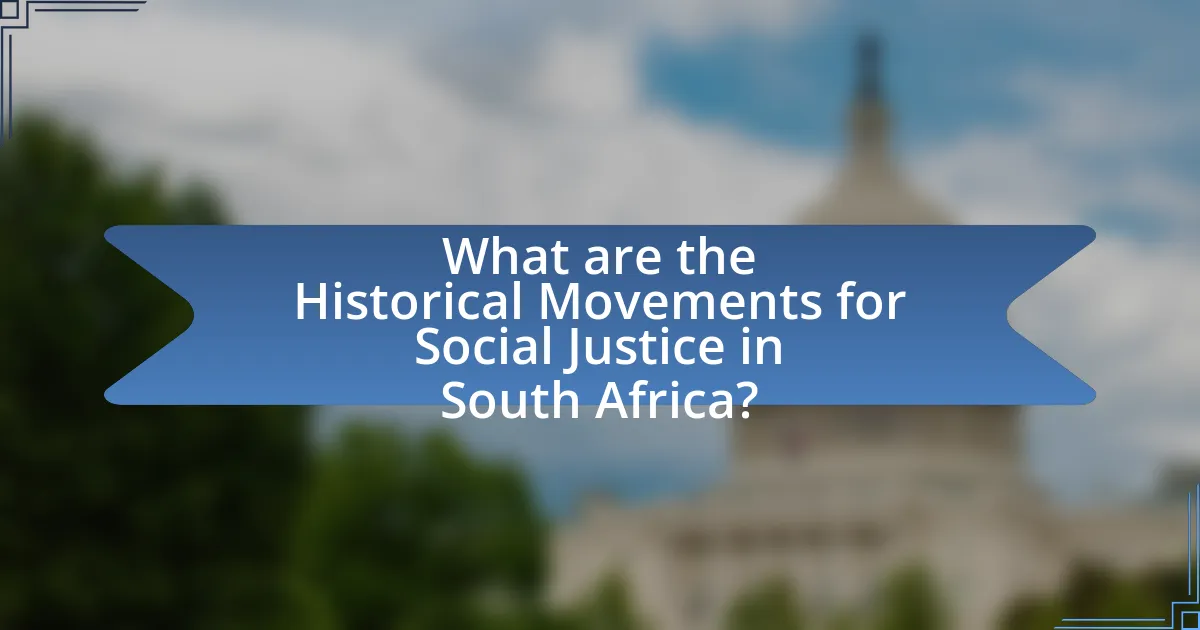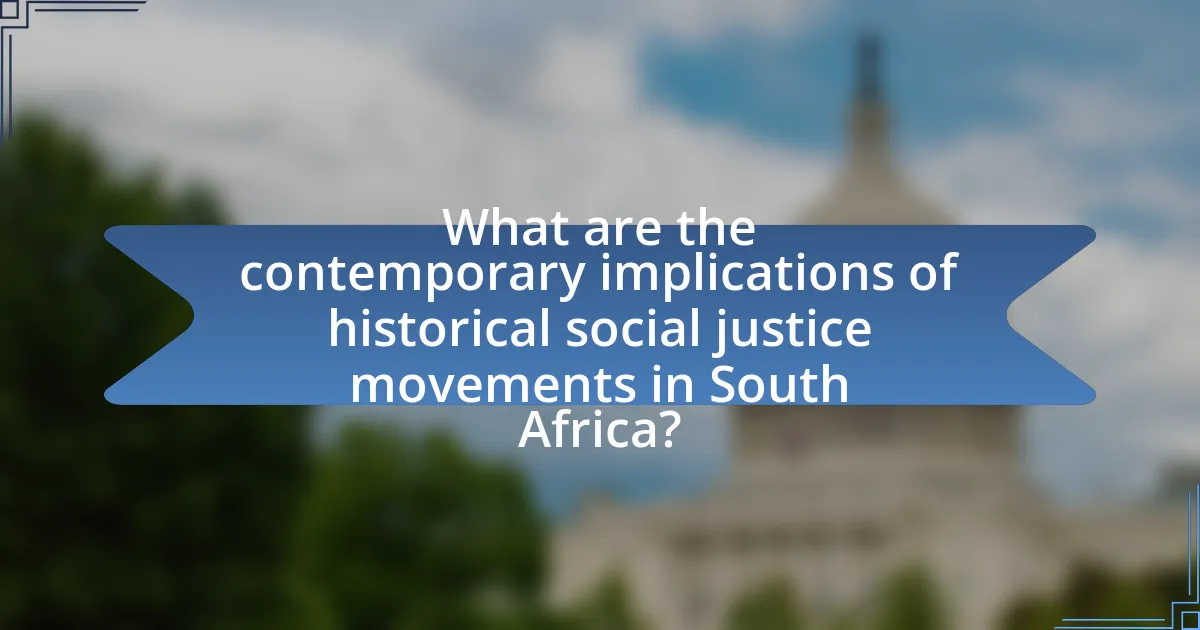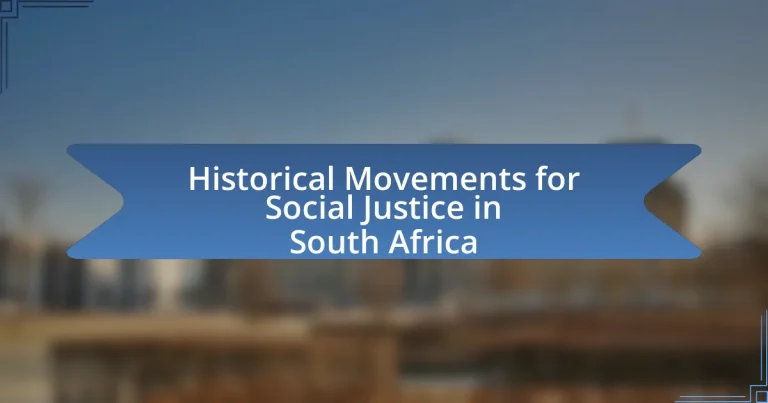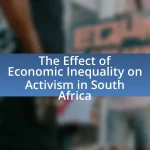The article focuses on the historical movements for social justice in South Africa, highlighting key organizations such as the African National Congress (ANC), the Black Consciousness Movement, and the United Democratic Front (UDF). It examines the emergence of these movements in response to apartheid, detailing the social, political, and economic factors that fueled their rise. Key figures like Nelson Mandela and Desmond Tutu are discussed, along with the objectives and milestones of these movements, including significant events like the Sharpeville Massacre and the Soweto Uprising. The article also explores the impact of grassroots activism, international support, and contemporary implications of these historical struggles on current social justice issues in South Africa.

What are the Historical Movements for Social Justice in South Africa?
The historical movements for social justice in South Africa include the African National Congress (ANC), the Black Consciousness Movement, and the United Democratic Front (UDF). The ANC, founded in 1912, aimed to end apartheid and promote equality, leading significant resistance against racial oppression. The Black Consciousness Movement, initiated in the 1960s by figures like Steve Biko, emphasized black pride and self-reliance, mobilizing youth against apartheid. The UDF, formed in 1983, united various anti-apartheid groups and played a crucial role in organizing protests and advocating for democratic rights. These movements collectively contributed to the dismantling of apartheid and the establishment of a democratic South Africa in 1994.
How did these movements emerge in South Africa?
Social justice movements in South Africa emerged primarily in response to systemic racial oppression and inequality under apartheid, which was institutionalized in 1948. The African National Congress (ANC) and other organizations mobilized against discriminatory laws, advocating for civil rights and equality. Key events, such as the Sharpeville Massacre in 1960, galvanized public sentiment and international attention, leading to increased activism. The Soweto Uprising in 1976 further highlighted the struggle against apartheid education policies, inspiring widespread resistance. These movements were characterized by grassroots organizing, labor strikes, and alliances with global anti-apartheid efforts, ultimately contributing to the dismantling of apartheid in the early 1990s.
What social, political, and economic factors contributed to the rise of these movements?
The rise of historical movements for social justice in South Africa was primarily driven by systemic racial oppression, economic inequality, and political disenfranchisement. The apartheid regime enforced racial segregation, denying the majority black population basic rights and freedoms, which galvanized resistance movements such as the African National Congress (ANC) and the Pan Africanist Congress (PAC). Economically, the exploitation of black labor in mines and agriculture created widespread poverty and discontent, prompting calls for equitable resource distribution and labor rights. Politically, the lack of representation for black South Africans in governance fueled demands for democratic reforms, culminating in mass protests and international solidarity efforts. These factors collectively created a fertile ground for the emergence and mobilization of social justice movements in South Africa.
Who were the key figures involved in these movements?
Key figures involved in historical movements for social justice in South Africa include Nelson Mandela, Desmond Tutu, and Oliver Tambo. Nelson Mandela was a prominent leader of the African National Congress (ANC) and played a crucial role in the anti-apartheid movement, advocating for equality and justice. Desmond Tutu, as the Archbishop of Cape Town, was a vocal opponent of apartheid and emphasized nonviolent resistance and reconciliation. Oliver Tambo, also a leader of the ANC, was instrumental in garnering international support against apartheid and promoting the struggle for liberation. These individuals significantly influenced the fight for social justice in South Africa, contributing to the eventual dismantling of apartheid.
What were the main objectives of these social justice movements?
The main objectives of social justice movements in South Africa were to achieve equality, dismantle apartheid, and promote human rights for all citizens. These movements aimed to end racial discrimination and segregation enforced by the apartheid regime, which institutionalized inequality from 1948 until the early 1990s. Key objectives included advocating for political representation, economic opportunities, and social justice for marginalized communities, particularly black South Africans. The African National Congress (ANC) and other organizations mobilized mass protests, strikes, and international solidarity campaigns to highlight injustices and push for legislative changes, culminating in the establishment of a democratic government in 1994.
How did these objectives evolve over time?
The objectives of historical movements for social justice in South Africa evolved significantly from the early 20th century to the present. Initially, these movements focused on basic civil rights and the elimination of discriminatory laws, as seen in the formation of the African National Congress (ANC) in 1912, which aimed to oppose racial discrimination and promote equal rights for all South Africans. Over time, particularly during the 1940s and 1950s, the objectives expanded to include broader social and economic justice, influenced by the rise of the Defiance Campaign in 1952, which sought to challenge apartheid laws through nonviolent resistance.
By the 1980s, the objectives further evolved to encompass not only the dismantling of apartheid but also the establishment of a democratic society that addressed systemic inequalities. This shift was marked by the formation of coalitions among various groups, including labor unions and student organizations, which emphasized the need for comprehensive social reforms. The transition to democracy in 1994 marked a significant milestone, as the objectives now included nation-building, reconciliation, and the promotion of human rights, as articulated in the new South African Constitution.
The evolution of these objectives reflects a response to changing political contexts, social dynamics, and the increasing recognition of the interconnectedness of civil, political, and economic rights.
What specific injustices were these movements addressing?
The historical movements for social justice in South Africa were primarily addressing systemic racial discrimination and inequality, particularly under apartheid. These movements sought to dismantle the legal framework that enforced racial segregation, which included laws that restricted the rights of non-white South Africans in areas such as education, employment, and political participation. For instance, the African National Congress (ANC) and other organizations highlighted injustices like the Group Areas Act, which forcibly removed non-white communities from designated areas, and the Bantu Education Act, which provided inferior education to black South Africans. These movements aimed to achieve equal rights and social justice for all citizens, regardless of race, thereby challenging the oppressive structures of apartheid.
What impact did these movements have on South African society?
The movements for social justice in South Africa significantly transformed society by dismantling apartheid and promoting equality. These movements, particularly the African National Congress and the Black Consciousness Movement, mobilized mass protests and international support, leading to the end of institutionalized racial segregation in 1994. The transition to a democratic government resulted in the establishment of a new constitution that enshrined human rights and equality for all citizens, fundamentally altering the social and political landscape. Furthermore, these movements fostered a sense of national identity and unity among diverse racial groups, contributing to ongoing dialogues about reconciliation and social justice in contemporary South Africa.
How did these movements influence legislation and policy changes?
Historical movements for social justice in South Africa significantly influenced legislation and policy changes by advocating for equality and human rights, leading to the dismantling of apartheid laws. The African National Congress (ANC) and other organizations mobilized mass protests and international support, which pressured the government to negotiate reforms. For example, the 1994 democratic elections marked the end of apartheid, resulting in the adoption of the Constitution of South Africa, which enshrined rights such as equality and non-discrimination. Additionally, the Truth and Reconciliation Commission established in 1995 aimed to address past injustices, further shaping policies around human rights and social justice. These movements created a framework for ongoing legislative changes that continue to address inequalities in South African society.
What role did grassroots activism play in these movements?
Grassroots activism was crucial in the historical movements for social justice in South Africa, as it mobilized communities to challenge systemic oppression and advocate for change. Activists at the local level organized protests, strikes, and community meetings, which were instrumental in raising awareness about injustices such as apartheid. For instance, the formation of the Black Consciousness Movement in the 1960s and 1970s galvanized widespread participation among black South Africans, fostering a sense of unity and resistance against racial discrimination. Additionally, grassroots organizations like the South African Council of Churches played a significant role in providing support and resources to activists, amplifying their voices in the struggle for equality.
What were the key historical milestones in South Africa’s social justice movements?
Key historical milestones in South Africa’s social justice movements include the formation of the African National Congress (ANC) in 1912, which aimed to fight for the rights of black South Africans. The Defiance Campaign of 1952 marked a significant escalation in resistance against apartheid laws, while the Sharpeville Massacre in 1960 galvanized international opposition to apartheid. The Soweto Uprising in 1976 highlighted the struggle for educational rights and drew global attention to the injustices faced by black South Africans. The unbanning of the ANC and the release of Nelson Mandela in 1990 were pivotal moments leading to the end of apartheid, culminating in the first democratic elections in 1994, which established a new government committed to social justice and equality.
What significant events marked the progress of these movements?
Significant events that marked the progress of social justice movements in South Africa include the 1944 formation of the African National Congress Youth League, which galvanized youth activism, and the 1960 Sharpeville Massacre, where police killed 69 peaceful protesters, leading to increased international condemnation of apartheid. Additionally, the 1976 Soweto Uprising, sparked by student protests against Afrikaans in schools, highlighted the struggle against oppressive education policies and mobilized global support for the anti-apartheid movement. The 1990 release of Nelson Mandela from prison symbolized a pivotal shift towards negotiations to end apartheid, culminating in the first multiracial elections in 1994, which marked the official end of apartheid and the establishment of a democratic South Africa.
How did the Sharpeville Massacre affect the anti-apartheid movement?
The Sharpeville Massacre significantly intensified the anti-apartheid movement by galvanizing both domestic and international opposition to apartheid policies. On March 21, 1960, police opened fire on a peaceful protest against pass laws, killing 69 people and injuring over 180. This brutal event drew widespread condemnation and highlighted the violent repression faced by anti-apartheid activists, leading to increased support for the African National Congress (ANC) and other liberation movements. The massacre also prompted the United Nations to take action, resulting in a resolution calling for the end of apartheid and the imposition of sanctions against South Africa, further isolating the apartheid regime and strengthening the resolve of anti-apartheid activists globally.
What was the significance of the Soweto Uprising in 1976?
The significance of the Soweto Uprising in 1976 lies in its role as a pivotal moment in the struggle against apartheid in South Africa. The uprising, which began on June 16, was a response to the imposition of Afrikaans as the medium of instruction in black schools, leading to widespread protests among students. This event galvanized international attention and support for the anti-apartheid movement, highlighting the brutal repression faced by black South Africans. The uprising resulted in the deaths of hundreds of students, with the iconic image of Hector Pieterson symbolizing the violence of the apartheid regime. Consequently, the Soweto Uprising became a catalyst for increased activism and resistance, both domestically and globally, ultimately contributing to the dismantling of apartheid in the early 1990s.
How did international support shape the movements for social justice in South Africa?
International support significantly shaped the movements for social justice in South Africa by providing resources, advocacy, and global awareness that amplified local struggles against apartheid. This support included economic sanctions, divestment campaigns, and diplomatic pressure from countries and organizations worldwide, which isolated the apartheid regime and highlighted human rights abuses. For instance, the international anti-apartheid movement, led by figures such as Nelson Mandela and supported by global entities like the United Nations, resulted in widespread protests and calls for boycotts, which ultimately contributed to the dismantling of apartheid policies in the early 1990s. Additionally, organizations like the African National Congress received funding and training from international allies, enhancing their capacity to mobilize and organize effectively against systemic oppression.
What role did global anti-apartheid campaigns play?
Global anti-apartheid campaigns played a crucial role in mobilizing international support against South Africa’s apartheid regime. These campaigns raised awareness about the injustices of apartheid, leading to widespread protests, economic sanctions, and divestment from companies operating in South Africa. For instance, the 1980s saw significant global movements, such as the Anti-Apartheid Movement in the UK, which organized demonstrations and lobbied for sanctions, contributing to the isolation of the apartheid government. Additionally, the United Nations imposed an arms embargo and called for economic sanctions, further pressuring South Africa to dismantle apartheid policies. The culmination of these efforts was instrumental in the eventual release of Nelson Mandela in 1990 and the transition to a democratic government in 1994.
How did sanctions and divestment impact the apartheid regime?
Sanctions and divestment significantly weakened the apartheid regime in South Africa by crippling its economy and isolating it internationally. Economic sanctions imposed by countries and organizations, such as the United Nations arms embargo in 1977 and trade restrictions, led to a decline in foreign investment and trade, which in turn caused economic instability. For instance, by the late 1980s, South Africa faced a recession, with unemployment rates soaring and inflation rising sharply. Additionally, divestment campaigns, particularly by universities and pension funds, pressured companies to withdraw investments, further diminishing the regime’s financial resources. The cumulative effect of these actions contributed to internal unrest and increased pressure for reform, ultimately leading to the dismantling of apartheid in the early 1990s.

What are the contemporary implications of historical social justice movements in South Africa?
The contemporary implications of historical social justice movements in South Africa include ongoing struggles for equality, land reform, and economic justice. These movements, particularly the anti-apartheid struggle, have shaped current policies and societal attitudes towards race and inequality. For instance, the legacy of the Freedom Charter continues to influence the South African Constitution, promoting human rights and social justice. Additionally, movements like the Economic Freedom Fighters advocate for land redistribution and economic equity, reflecting the unresolved issues from past injustices. The persistence of protests against inequality, such as the Fees Must Fall movement, demonstrates that the fight for social justice remains relevant and urgent in contemporary South Africa.
How do historical movements influence current social justice issues?
Historical movements significantly shape current social justice issues by establishing foundational frameworks for activism and policy change. For instance, the anti-apartheid movement in South Africa laid the groundwork for contemporary struggles against racial inequality and economic disparity. This movement, which culminated in the 1994 democratic elections, highlighted the importance of collective action and legal reforms, influencing current campaigns for land redistribution and equitable access to resources. The legacy of leaders like Nelson Mandela and organizations such as the African National Congress continues to inspire modern social justice initiatives, demonstrating how historical contexts inform present-day advocacy and policy agendas.
What lessons can be learned from past movements for today’s activists?
Today’s activists can learn the importance of unity and strategic planning from past movements in South Africa, such as the anti-apartheid struggle. The success of the African National Congress (ANC) and its allies demonstrated that collective action and a clear, shared vision can mobilize diverse groups towards a common goal. Historical evidence shows that the ANC’s ability to unite various factions, including labor unions and student organizations, was crucial in building a broad-based movement that ultimately led to the end of apartheid in 1994. Additionally, the use of nonviolent resistance, as exemplified by figures like Nelson Mandela and Desmond Tutu, highlights the effectiveness of peaceful protest in achieving social change. These lessons emphasize the need for collaboration, strategic communication, and a commitment to nonviolence in contemporary activism.
How do current movements reflect the legacy of historical struggles?
Current movements in South Africa reflect the legacy of historical struggles by continuing the fight for social justice, equality, and human rights that were central to the anti-apartheid movement. For instance, the #FeesMustFall movement, which emerged in 2015, echoes the earlier struggles against racial discrimination and economic inequality, advocating for accessible education for all, similar to how the anti-apartheid activists fought for equal rights. This connection is evident in the way contemporary activists reference the sacrifices made by figures like Nelson Mandela and the broader anti-apartheid coalition, reinforcing the idea that current social justice issues are part of an ongoing struggle rooted in historical context.
What challenges do contemporary social justice movements face in South Africa?
Contemporary social justice movements in South Africa face significant challenges, including systemic inequality, political corruption, and social fragmentation. Systemic inequality persists due to the legacy of apartheid, where economic disparities remain entrenched; for instance, the World Bank reported in 2020 that South Africa has one of the highest Gini coefficients globally, indicating extreme income inequality. Political corruption undermines trust in institutions, as evidenced by numerous scandals involving government officials, which distract from social justice agendas. Additionally, social fragmentation, often along racial and economic lines, complicates coalition-building among diverse groups advocating for change, making it difficult to present a unified front. These challenges hinder the effectiveness and reach of social justice movements in their pursuit of equity and reform.
How do socio-economic disparities affect current activism?
Socio-economic disparities significantly influence current activism by shaping the priorities and strategies of movements. Activists from marginalized communities often focus on issues like poverty, unemployment, and access to education, which are exacerbated by these disparities. For instance, in South Africa, the legacy of apartheid has resulted in persistent economic inequalities, leading to movements such as #FeesMustFall, which addresses the financial barriers to higher education. Research by the South African Institute of Race Relations indicates that the wealth gap remains stark, with the top 10% of earners holding more than 50% of the country’s wealth. This economic divide fuels activism as individuals and groups mobilize to demand equitable resources and opportunities, highlighting the direct correlation between socio-economic status and the urgency of social justice initiatives.
What role does government policy play in shaping modern movements?
Government policy significantly influences modern movements by establishing the legal and social framework within which these movements operate. In South Africa, for instance, policies such as the Promotion of Equality and Prevention of Unfair Discrimination Act of 2000 have provided a legal basis for social justice movements, enabling activists to challenge discrimination and advocate for equality. Additionally, government responses to movements, such as the enactment of the National Development Plan, can either support or hinder progress, shaping the strategies and goals of these movements. Historical context shows that policies enacted during the apartheid era, such as the Group Areas Act, directly fueled resistance movements, illustrating how government actions can provoke social mobilization.
What practical strategies can be employed for effective social justice activism today?
Effective social justice activism today can be employed through grassroots organizing, digital advocacy, and coalition-building. Grassroots organizing involves mobilizing local communities to address specific issues, as seen in the anti-apartheid movement in South Africa, where community-led initiatives played a crucial role in raising awareness and driving change. Digital advocacy leverages social media platforms to amplify voices and reach wider audiences, exemplified by movements like #BlackLivesMatter, which gained global traction through online campaigns. Coalition-building fosters collaboration among diverse groups, enhancing the impact of activism; for instance, the formation of the Treatment Action Campaign in South Africa united various stakeholders to advocate for access to HIV/AIDS treatment. These strategies are effective as they create inclusive platforms for dialogue, empower marginalized voices, and facilitate sustained engagement in social justice issues.
How can grassroots organizations mobilize communities for change?
Grassroots organizations can mobilize communities for change by fostering local leadership, building networks, and facilitating access to resources. These organizations empower individuals by providing training and support, enabling them to advocate for their rights and address community issues effectively. For instance, the Treatment Action Campaign in South Africa successfully mobilized communities to demand access to HIV/AIDS treatment, leading to significant policy changes. This demonstrates that grassroots efforts can create substantial social impact by engaging community members in collective action and advocacy.
What are the best practices for building coalitions among diverse groups?
The best practices for building coalitions among diverse groups include fostering open communication, establishing shared goals, and promoting inclusivity. Open communication ensures that all voices are heard, which is crucial for understanding different perspectives and building trust. Establishing shared goals aligns the interests of diverse groups, creating a common purpose that motivates collaboration. Promoting inclusivity involves actively engaging underrepresented voices, which enhances the coalition’s effectiveness and legitimacy. Historical examples, such as the anti-apartheid movement in South Africa, demonstrate that these practices lead to successful alliances that can drive significant social change.


